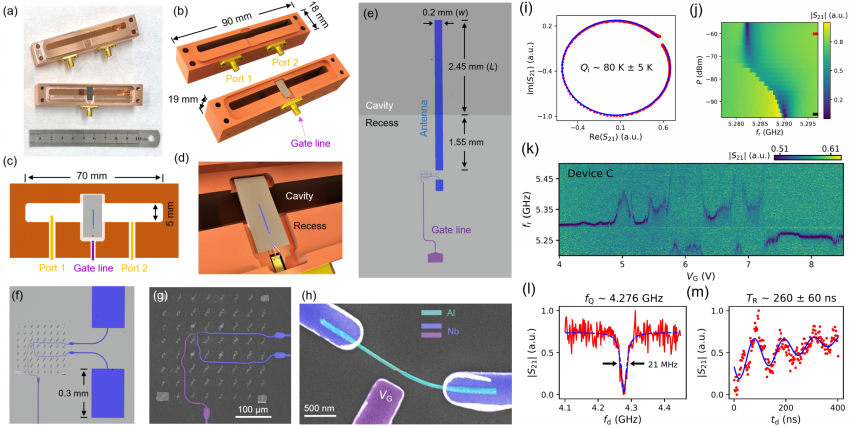Semiconductor-superconductor hybrid qubits offer a powerful platform for studying the microwave responses of hybrid devices. One example is the gatemon qubits based on semiconductor nanowires, which hold relevance in topological quantum computation, as the same material has been predicted to host Majorana zero modes. In previous experiments, 2D resonators using superconducting co-planar waveguides were implemented to probe and control those gatemon qubits. Implementing 3D cavity is challenging, as the presence of gate lines can severely degrade the cavity quality. Recently, the team lead by Prof. Hao Zhang has proposed a new design to address this issue, and realized a gatemon device in a 3D cavity, compatible with gate lines.

(a) Image of the 3D cavity and device chip, (b-d) Schematic of the design., (e-h) Optical images and SEM of the device chip, (i) Quality factor fit of the 3D copper cavity, (j) Cavity shift, (k) Gate-tunable cavity shift, (l) Qubit spectroscopy, (m) Rabi oscillations.
Panel (a) in the figure above shows the image of the 3D cavity and device chip, with its schematic shown in (b-d). The major modification of the 3D cavity is a small recess machined on its side wall. The device, an InAs-Al Josephson junction and its gate line, is placed in this recess, avoiding direct coupling to the 3D cavity modes and preventing degradation. The device is connected to a long superconducting thin film, the antenna, which extends into the cavity center. The antenna couples the device to the 3D cavity. The device and antenna together form a gatemon qubit, see (e-h) for the images. The quality factor, Qi, of the 3D copper cavity can reach 80k, see panel (i). The qubit-induced cavity shift is observed in (j). This shift is gate-tunable, as shown in (k). Qubit spectroscopy and preliminary Rabi oscillations can be observed (l-m). This work enables the probing of gate-tunable quantum devices in a 3D cavity.
The work, entitled “Gate-compatible circuit quantum electrodynamics in a three-dimensional cavity architecture”, is published in Physical Review Applied. The first authors are Zezhou Xia, Jierong Huo, Zonglin Li, Dr. Jianghua Ying, and Dr. Yulong Liu. The corresponding author is Prof. Hao Zhang. The work is supported by the National Natural Science Foundation of China, Ministry of Science and Technology of China, Tsinghua University Initiative Scientific Research Program, Beijing Municipal Science and Technology Commission.
Paper Link: https://link.aps.org/doi/10.1103/PhysRevApplied.21.034031